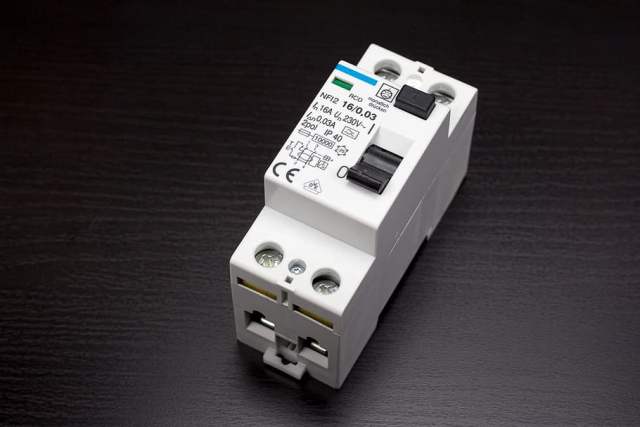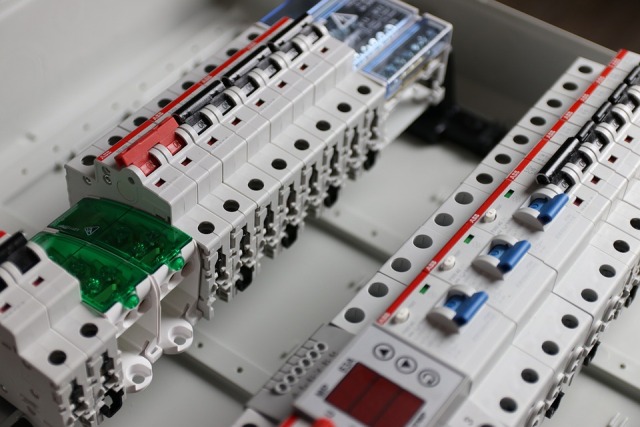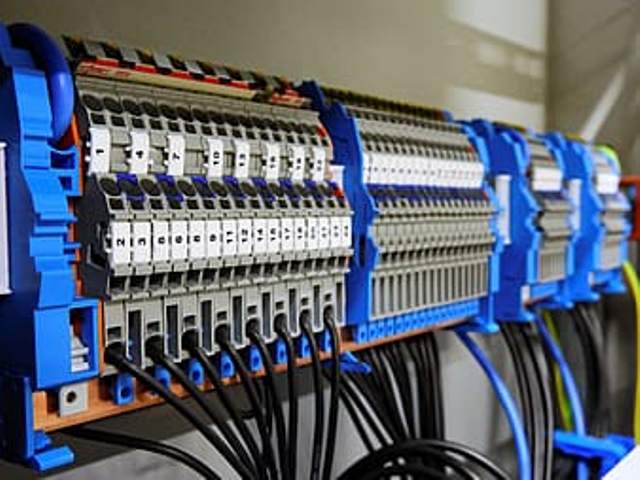Definition of electric current
Electric current is the movement of electrons through a conductive material:
– If this movement always takes place in the same direction, it is called direct current.
– The electric current supplied by the electricity suppliers in our homes is alternating: the electrons first move in one direction and then in the opposite direction at regular intervals.
Current intensity
The intensity of an electric current is expressed in amperes (symbol: A). It measures the amount of electricity, i.e. the number of electrons, flowing through a circuit during an interval of time.
Voltage of electric current
The volt (symbol: V) is the unit of potential difference or voltage. In a pictorial way, this would correspond for example to the pressure of the water retained in a dam: a large potential difference in a closed circuit involves the displacement of a large number of electrons.
Power of the current
An electric current is characterized by a power, expressed in watts (symbol: W). Power is the product of voltage and current.
Power (in watts) = current (in amperes) × voltage (in volts)
This power is generally calculated for a duration of one hour, hence the kilowatt-hour unit (equivalent to 3,600,000 joules).
Which electrical power should I choose?
This is the first question that arises when you sign a contract with an electricity distributor. In theory, the electrical power required is the sum of the power of all the electrical appliances you have at your disposal.
In reality, however, it is much lower, since not all appliances work at the same time. The type of accommodation and the nature of your electrical equipment will be the two main elements to consider in finding the most suitable subscription.
Different electrical power according to the subscription
You can thus subscribe to power ratings from 3 to 36 kVa:
– 3 kVa: a small (studio type) dwelling equipped with commonly used electrical appliances or a second home not heated by electricity.
– 6 kVa: 100 m2 dwelling, not heated by electricity and equipped with small electrical appliances, television, refrigerator + freezer, oven, storage water heater.
– 9 kVa: 100 m2 dwelling heated by electricity (convectors or radiant panels) with, in addition to the basic electrical appliances, a number of audiovisual and computer equipment.
– 12 kVa: large electrically heated dwelling (convectors or accumulators) with complete electrical household appliances and a wide range of audio-visual and computer equipment.
– 15, 18, 24, 30, or 36 kVa: offers for very large dwellings such as poorly insulated, over-equipped lofts with electric radiant floor heating.
The price of the subscription is more expensive with the higher electrical power you subscribe to.
Electric power: what happens if you exceed the limit?
In the event that the chosen power level is exceeded, the general circuit breaker will be tripped and the power supply will be cut off throughout the entire property. It must then be restarted manually.
To avoid this type of inconvenience, the circuit breaker and the load-shedding unit are two useful devices.
Types of circuit breaker

There are 3 types of circuit breaker:
– the general or branch circuit breaker;
– the divisional circuit breakers;
– earth leakage circuit breakers.
General circuit breaker
The main circuit breaker protects the electrical installation and people. It ensures the emergency shutdown of the entire installation in case of a problem.
It is set according to the subscription (power) chosen by the user. If too many electrical appliances are operating at the same time and exceed the power subscription, it breaks and cuts off the current.
This circuit breaker must be installed inside the housing, in the electrical panel. However, the general circuit breaker is not sufficient to ensure the protection of your installation, other devices (as seen below) must be installed.
Divisional circuit breaker
Subdivisional circuit breakers ensure the protection of the various electrical circuits of your installation.
In the event of a problem, it breaks the circuit responsible for the overload or short circuit.
Its handle is lowered so that you can see which circuit is involved. Once the problem has been solved, for example after disconnecting the electrical appliance causing the problem, simply raise the lever to restore power.
Earth leakage circuit breaker

Highly sensitive differential circuit breakers (30 mA) protect circuits from overloads and short circuits, but also protect people from the risk of electric shock.
The sensitivity corresponds to the tripping (i.e. breaking) threshold in the event of power leakage.
For domestic installations, a high sensitivity of 30 mA or less is required.
Role of the load-shedding device
The load-shedding device is not an indispensable part of an electrical installation but is nevertheless very advantageous.
The load-shedding unit is a device that automatically manages the power supply to the appliances.
When the power consumption risks exceeding the threshold of the subscribed power, the load-shedding device cuts off the power supply to the circuits deemed to be non-priority (such as room heating) but leaves the priority circuits supplied.
A load-shedding device can save up to 50% of the subscription price.
Types of load-shedders

There are different types of load shedders:
– When the penalties are always in the same order (load shedding of circuit 1 then 2 then 3 if the consumption overrun persists), the load shedding is called cascade load shedding.
– To prevent the same part of the dwelling from always being penalized, certain types of load-shedders alternate power cuts on several circuits for short periods (a few minutes). This rotation system is called cyclic.
– Finally, the two systems can be combined. The load shedding will be cyclic as a first intention and becomes cascade if that is not enough.
If you wish, we can put you in touch with one or more electrical installation specialists. They will be able to give you a quotation for your convenience.

